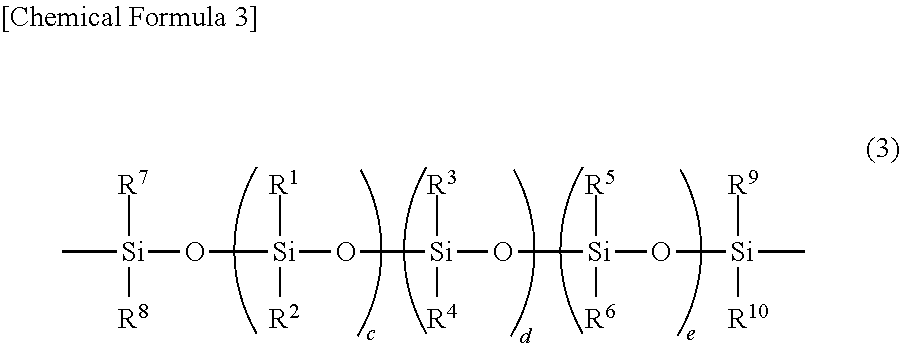Curable composition for semiconductor encapsulation
a technology of curable composition and semiconductor, which is applied in the directions of semiconductor/solid-state device details, transportation and packaging, layered products, etc., can solve the problems of unsatisfactory organopolysiloxane resin, deterioration of electrical insulation properties, and inability to obtain encapsulating material/insulating material to date, etc., to achieve satisfactory heat resistance, excellent heat resistance, electrical insulation properties
- Summary
- Abstract
- Description
- Claims
- Application Information
AI Technical Summary
Benefits of technology
Problems solved by technology
Method used
Image
Examples
synthesis example 1
Production of Compound A-1
[0166]In a glass reaction vessel equipped with a nitrogen gas inlet tube, a thermometer and a stirring apparatus, 106.7 g (0.135 mol) of octaphenyltetrasiloxane, 468.3 g (1.56 mol) of octamethyltetrasiloxane, and 10.4 g (0.15 mol) of potassium methoxide were introduced, and the mixture was allowed to react while stirred for 2 hours at 150° C. in a nitrogen atmosphere. After the reaction liquid was cooled, 575 g of toluene as a solvent, and 1150 g of a 22% aqueous hydrochloric acid solution were added thereto, and the resulting mixture was allowed to react while stirred for 22 hours at 90° C. Thereafter, the water content in the reaction liquid was reduced to 10 ppm or less by refluxing toluene, while removing water in an azeotropic manner. The reaction liquid was cooled to 25° C., and then 193 g of pyridine was added thereto. Subsequently, 153.2 g (1.62 mol) of dimethylchlorosilane as a halosilane compound was added dropwise to the reaction liquid under sti...
synthesis example 2
Production of Compound A-2
[0167]The same procedure as in Synthesis Example 1 was carried out, except that the amount of octaphenyltetrasiloxane used was changed from 106.7 g (0.135 mol) to 159.5 g (0.201 mol), and the amount of octamethyltetrasiloxane used was changed from 468.3 g (1.56 mol) to 415.5 g (1.40 mol), and thus 432 g (yield 73%) of a compound A-2 was obtained, which was the component (A) according to the present invention. The mass average molecular weight of the compound A-2 was 10900, the number average molecular weight was 4150, and the SiH group content of the compound A-2 was 0.35 mmol / g. Furthermore, the proportion of the number of aryl groups each having 6 to 10 carbon atoms and bonded to silicon atoms, with respect to the sum of the number of alkyl groups each having 1 to 4 carbon atoms and bonded to silicon atoms and the number of aryl groups each having 6 to 10 carbon atoms and bonded to silicon atoms in one molecule, was 0.13, and the content of Y1—CH2CH2 grou...
synthesis example 3
Production of Compound A-3
[0168]The same procedure as in Synthesis Example 1 was carried out, except that the amount of octaphenyltetrasiloxane used was changed from 106.7 g (0.135 mol) to 344.7 g (0.435 mol), and the amount of octamethyltetrasiloxane used was changed from 468.3 g (1.56 mol) to 230.3 g (0.778 mol), and thus 426 g (yield 72%) of a compound A-3 was obtained, which was the component (A) according to the present invention. The mass average molecular weight of the compound A-3 was 10700, the number average molecular weight was 4050, and the SiH group content of the compound A-3 was 0.36 mmol / g. Furthermore, the proportion of the number of aryl groups each having 6 to 10 carbon atoms and bonded to silicon atoms, with respect to the sum of the number of alkyl groups each having 1 to 4 carbon atoms and bonded to silicon atoms and the number of aryl groups each having 6 to 10 carbon atoms and bonded to silicon atoms in one molecule, was 0.36, and the content of Y1—CH2CH2 gro...
PUM
| Property | Measurement | Unit |
|---|---|---|
| molar ratio | aaaaa | aaaaa |
| heat resistance limit temperature | aaaaa | aaaaa |
| heat resistance limit temperature | aaaaa | aaaaa |
Abstract
Description
Claims
Application Information
 Login to View More
Login to View More - R&D
- Intellectual Property
- Life Sciences
- Materials
- Tech Scout
- Unparalleled Data Quality
- Higher Quality Content
- 60% Fewer Hallucinations
Browse by: Latest US Patents, China's latest patents, Technical Efficacy Thesaurus, Application Domain, Technology Topic, Popular Technical Reports.
© 2025 PatSnap. All rights reserved.Legal|Privacy policy|Modern Slavery Act Transparency Statement|Sitemap|About US| Contact US: help@patsnap.com



